Skip to: Upper leaves // Leaf undersides // Tricks and challenges // Pretty pictures
As of May 2023, there are eighteen named cultivars or groups of Tradescantia zebrina – that’s more than any other individual species in the genus. But lots of people have no idea there are so many different types! In this article I’ve gathered comparison pictures of all the different zebrina cultivars in different growing conditions, as well as focusing on some specific challenging lookalikes.
For the photos that include every cultivar, I’ve taken three versions showing plants grown in three different sets of environmental conditions:
- Grown indoors in artificial light. Temperatures are at a stable 20-24ºC, and the lights are on a 12-hour cycle but not as bright as sun. This is generally the “low stress” condition. Plants tend to stay fairly green, with thin stems and soft leaves.
- Grown in an unheated conservatory (UK summer). Temperatures generally range from 10-35ºC with a fairly intense day/night cycle, and the plants get a lot of direct sun. This is a “moderate-high stress” condition. Plants show more intense red and purple pigments and become a bit more robust.
- Grown outdoors in full sun (UK summer). Temperatures generally range from 10-25ºC, the plants are in full direct sun, and also subject to the full intensity of wind and rain (here in West Wales, that’s a lot!). This is the “high stress” condition. Plants show their most intense red and purple pigments, and leaves and stems become very thick and succulent. There are often some yellowing or damaged leaves from sun scorch, fungus, bugs, and other environmental challenges.
These three sets show a good range of the possible variation for each cultivar. But it’s pretty much impossible to capture every potential look – tradescantias are notoriously variable, and zebrinas are probably the most variable of all.
The only cultivar not included in these pictures is ‘Purple Highway’, which I’ve never found for sale under its patented name. I’m still researching to try and figure out what this name refers to, and whether it’s sold with a different name or just not in circulation.
Note from December 2023: ‘Purple Highway’ is now known to belong to the Superba Group, which is not an individual cultivar after all. In these pictures, you can consider the plants labelled ‘Superba’ to be representatives of the group overall, which includes ‘Purple Highway’ and some unnamed clones.
Note from July 2024: The number of T. zebrima cultivars given in this article is out of date, because more have been introduced since it was written. The comparison photos should not be considered a complete list of all zebrinas. They are only a snapshot of the zebrinas that existed at the time.
Upper leaves
The upper surfaces of the leaves show all the most interesting characteristics.
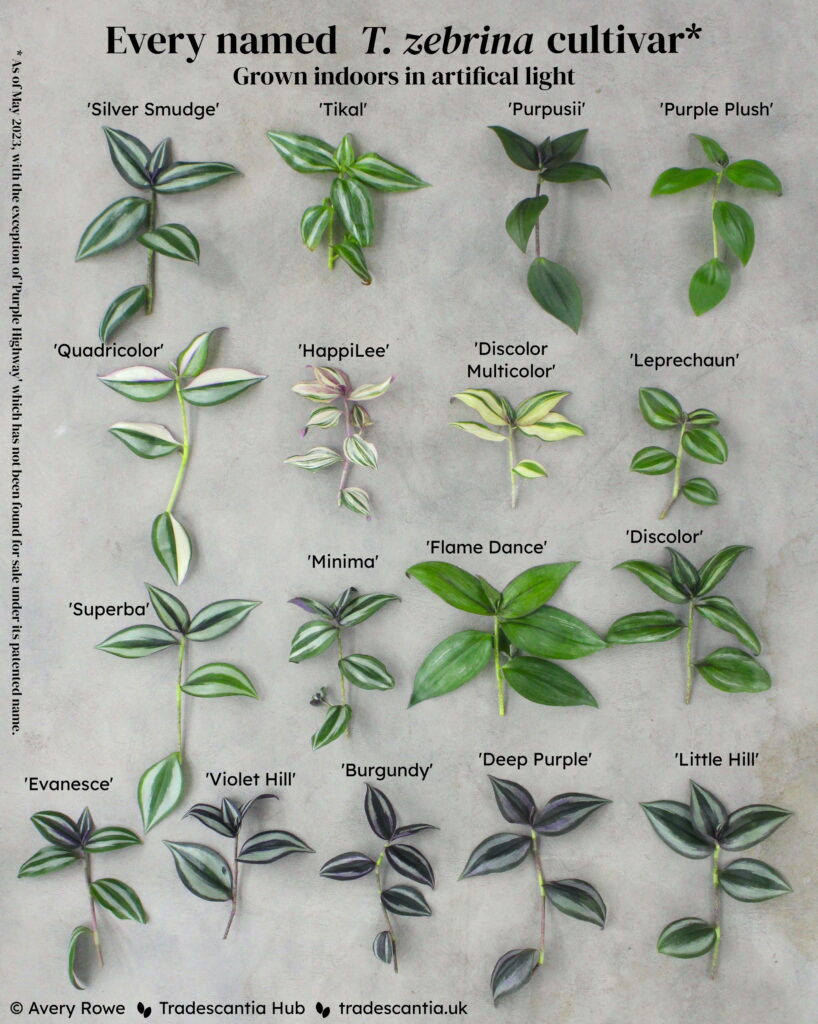
These indoor plants show how each cultivar is likely to look as a houseplant grown out of direct sun. Most of them are showing mostly bright green tones, and their silver bands are always clearly delineated from the background colour.
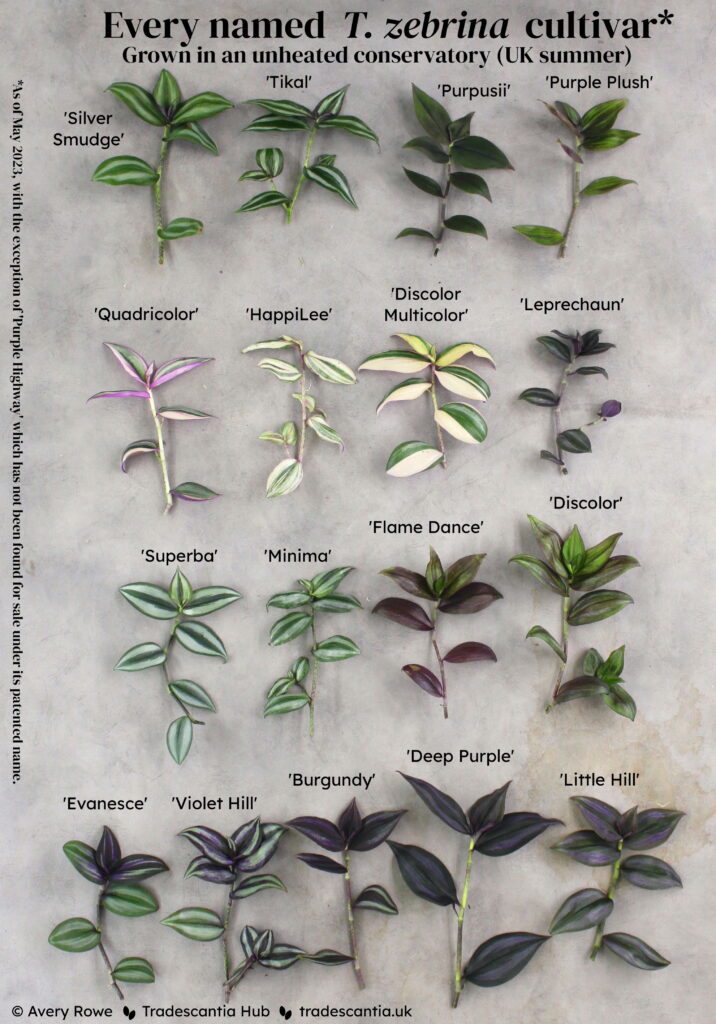
The conservatory-grown plants are more robust and darker with red and purple pigments. For some cultivars this brings out their unique features more clearly, but for others the reduced contrast on the silver bands makes them harder to distinguish from each other.
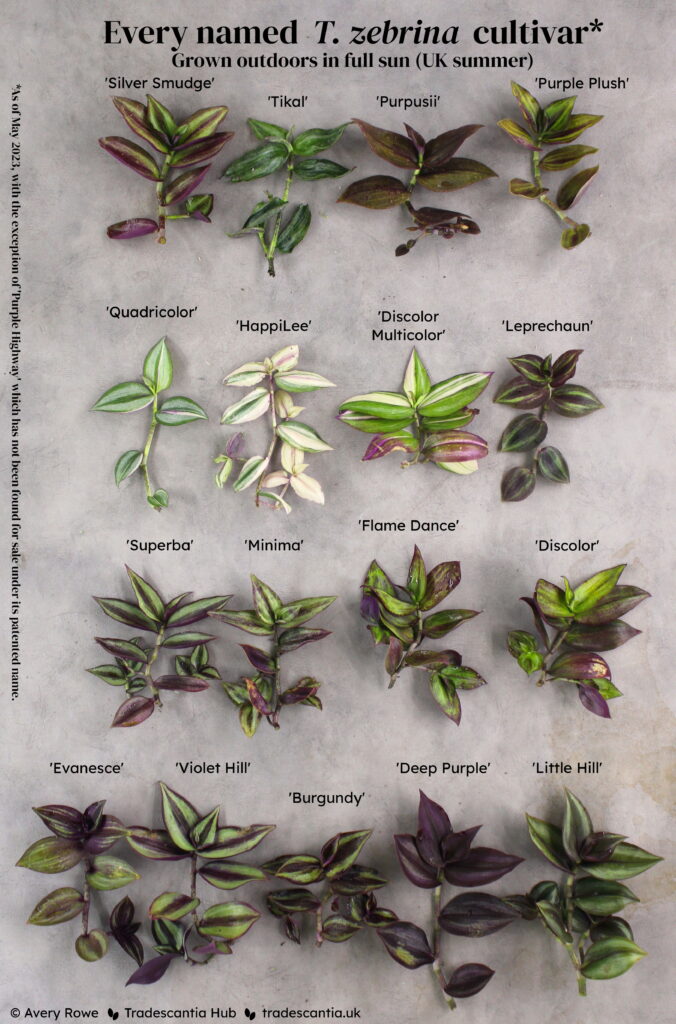
Grown outdoors, most cultivars become very compact and succulent, and show even more deep red and purple pigments. But strangely, the parts that remain green often become paler or yellow because of stress. The contrast in the stripe patterns is increased for some cultivars and decreased for others.
Leaf undersides
The leaf undersides are generally less variable, but still interesting to compare.

Even in low light indoors most cultivars have purple leaf undersides, but some do have pale green streaks along the veins. The sectoral variegated cultivars stand out because their pale sectors are bright pink or white from below.
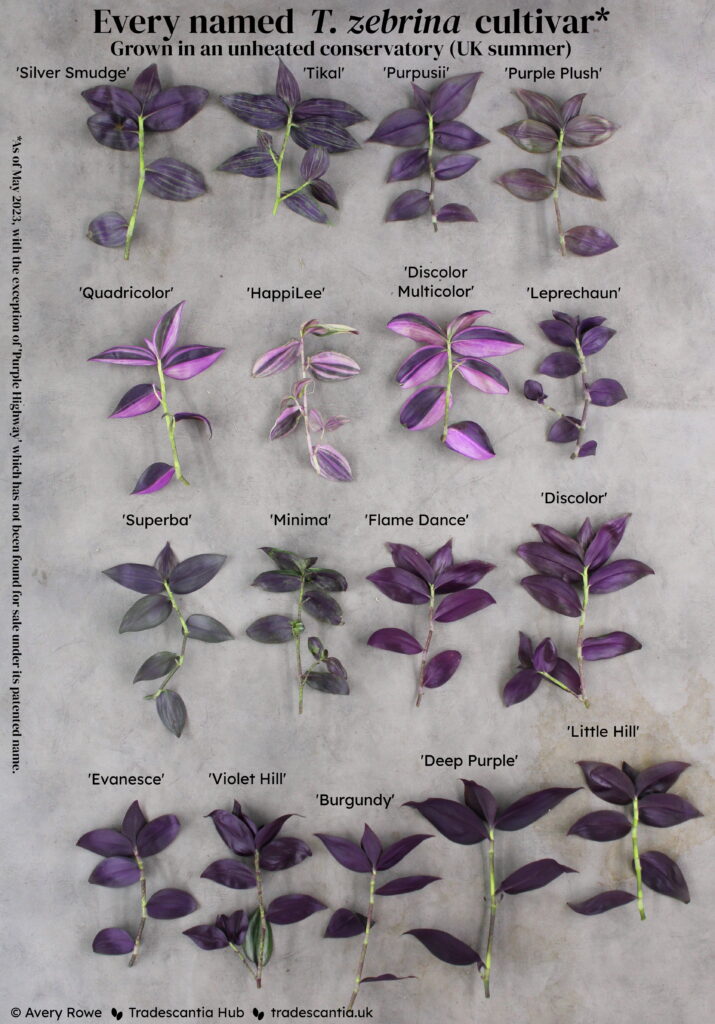
The conservatory-grown plants are almost all completely purple underneath, apart from variegated sectors. But even so, some cultivars are noticeably darker, paler, or redder than others.
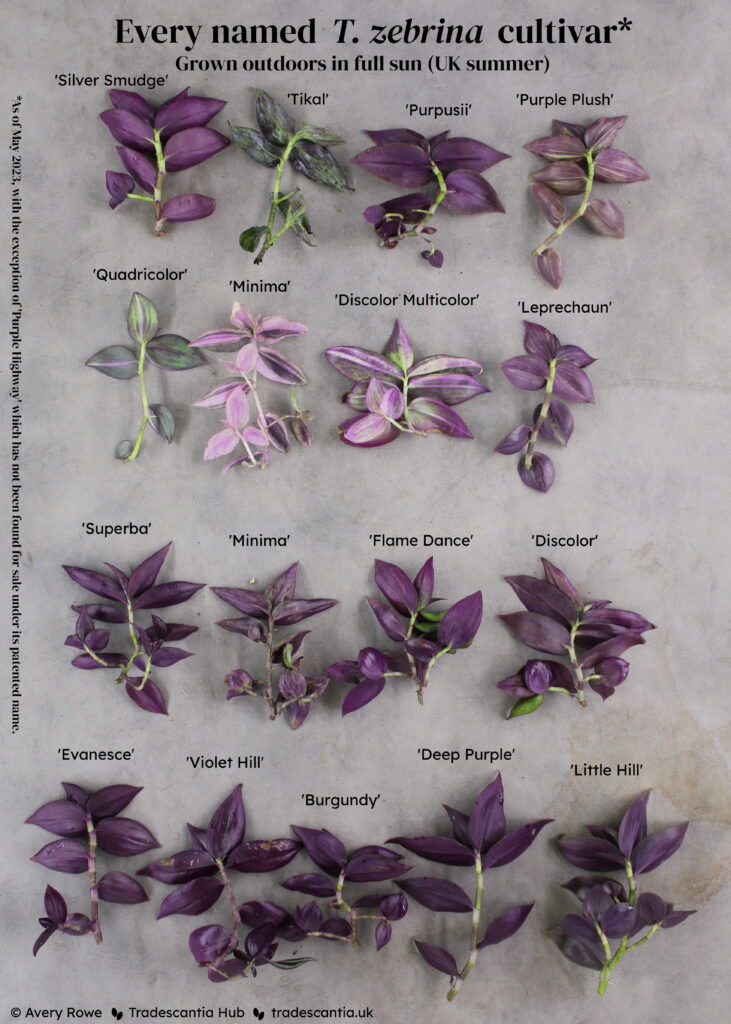
In full sun they’re also very purple, apart from variegated pink sectors. Although the sickly-looking ‘Tikal’ shows more pale splotches here than grown in the conservatory – it seems to be unhappy almost wherever it grows.
Tricks and challenges
Like with many plants, people often don’t use the precise cultivar name to describe their zebrina. But because there are so many different zebrina cultivars, it can be very difficult to identify them without a precise name.
If someone says they have a “variegated cobweb plant”, it’s easy to know they’re referring to Tradescantia sillamontana ‘Gold Stripes’ – there’s only one variegated cultivar of that species. But if someone says they have a “purple zebrina”, they could mean…
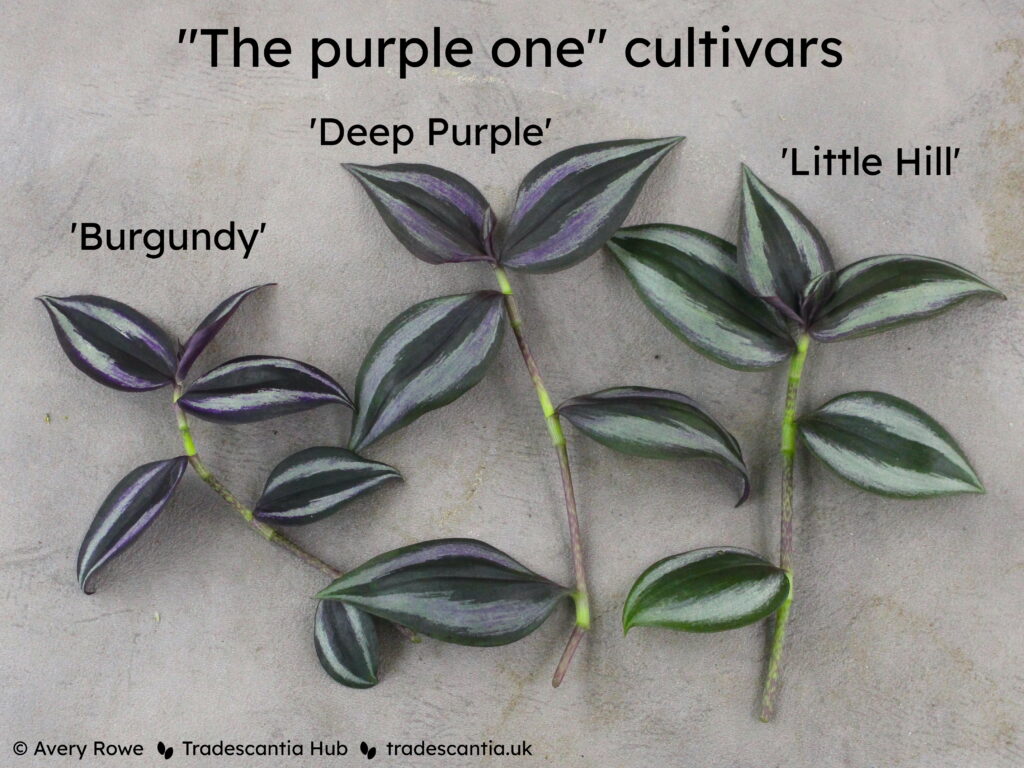
The same goes for the three sectoral variegated cultivars, which I have a whole article about identifying.
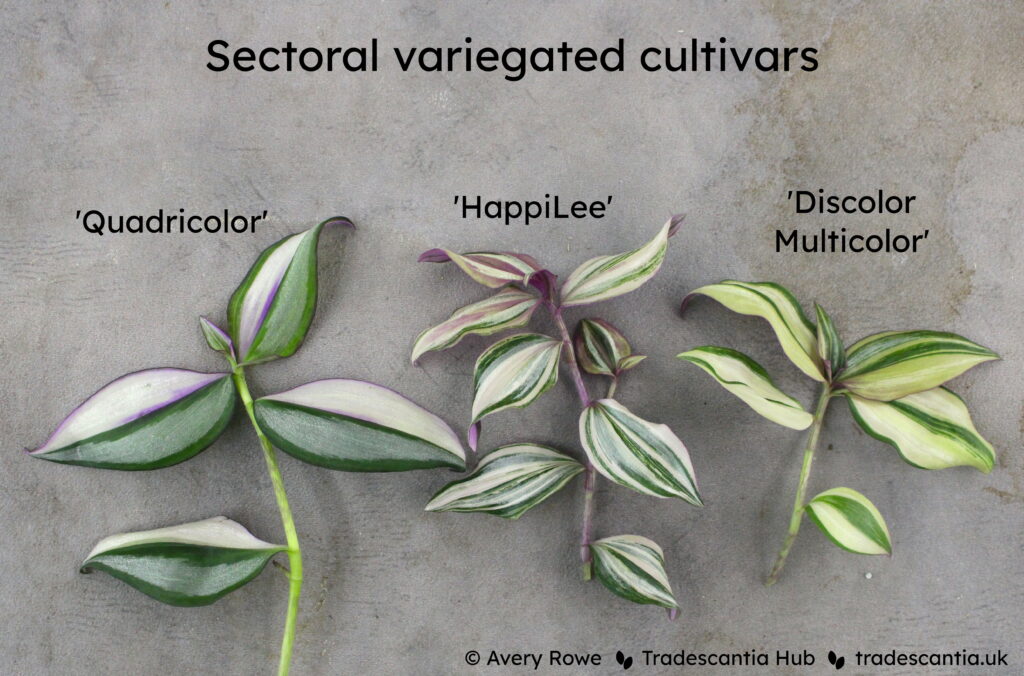
There are a few cultivars which get unhelpfully called “wild type”. Most of these probably were wild collections a long time ago, which is why they’re also some of the oldest cultivars around – probably the plants you’ve inherited from people who have been growing them a very long time. But as I’ve written before, “wild type” doesn’t really mean much and is a pretty unhelpful descriptor for cultivated plants. It certainly doesn’t uniquely identify a single T. zebrina cultivar.
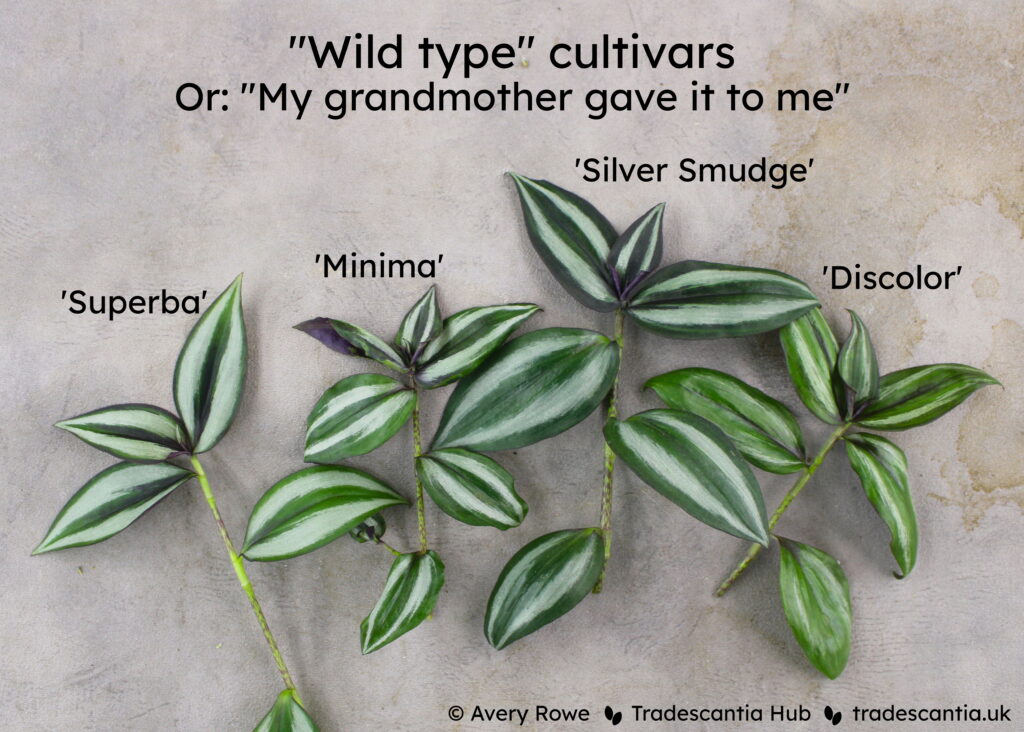
Since the most characteristic feature of T. zebrina as a species is the silver bands on its leaves, it’s tempting to think that “the one without stripes” would at least narrow down the ID to one unique cultivar? Nope.
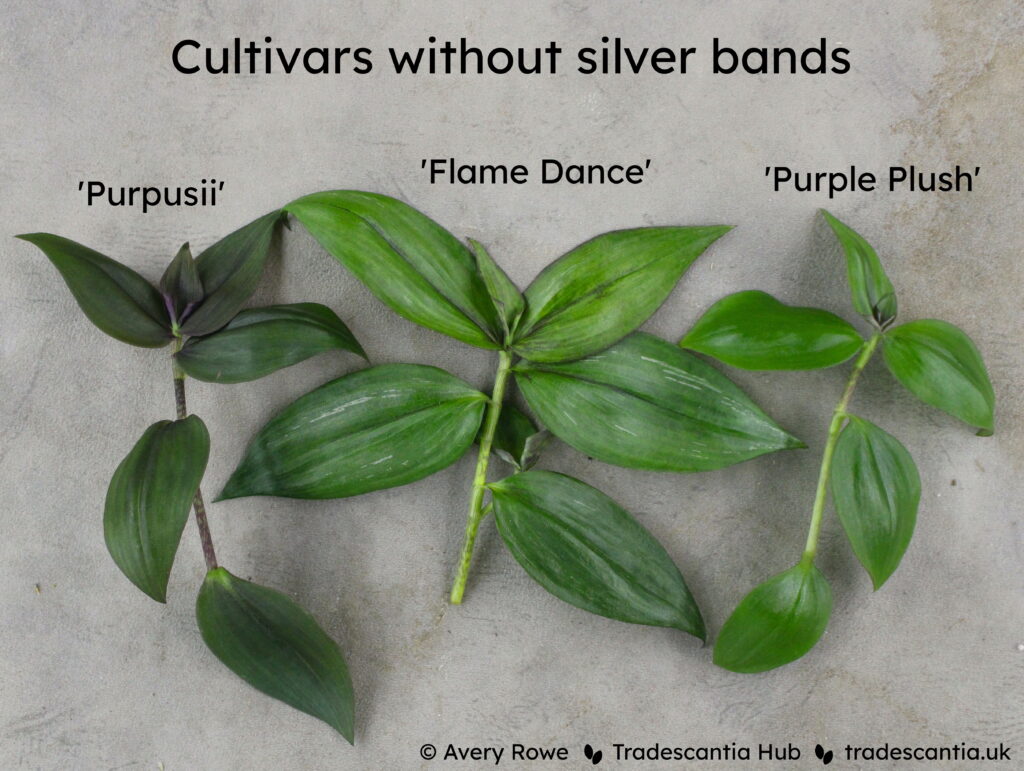
One particular tricky pair is ‘Discolor’ and ‘Flame Dance’. They’re very similar, and most likely one originated as a mutation from the other. In intense light, they both lose the silver on their leaves and become indistinguishable in dramatic shades of red and purple. But in lower light, the only difference between them is the pattern of their silver bands. On ‘Flame Dance’, the bands are broken up into scattered streaks, which sometimes disappear completely. On ‘Discolor’ there are narrow but solid bands on every leaf.

Perhaps the most frustrating description of a plant is “just regular zebrina”. Depending on what’s meant by “regular” (common? stripy? old-fashioned?), it could refer to nearly half of all the cultivars in circulation!
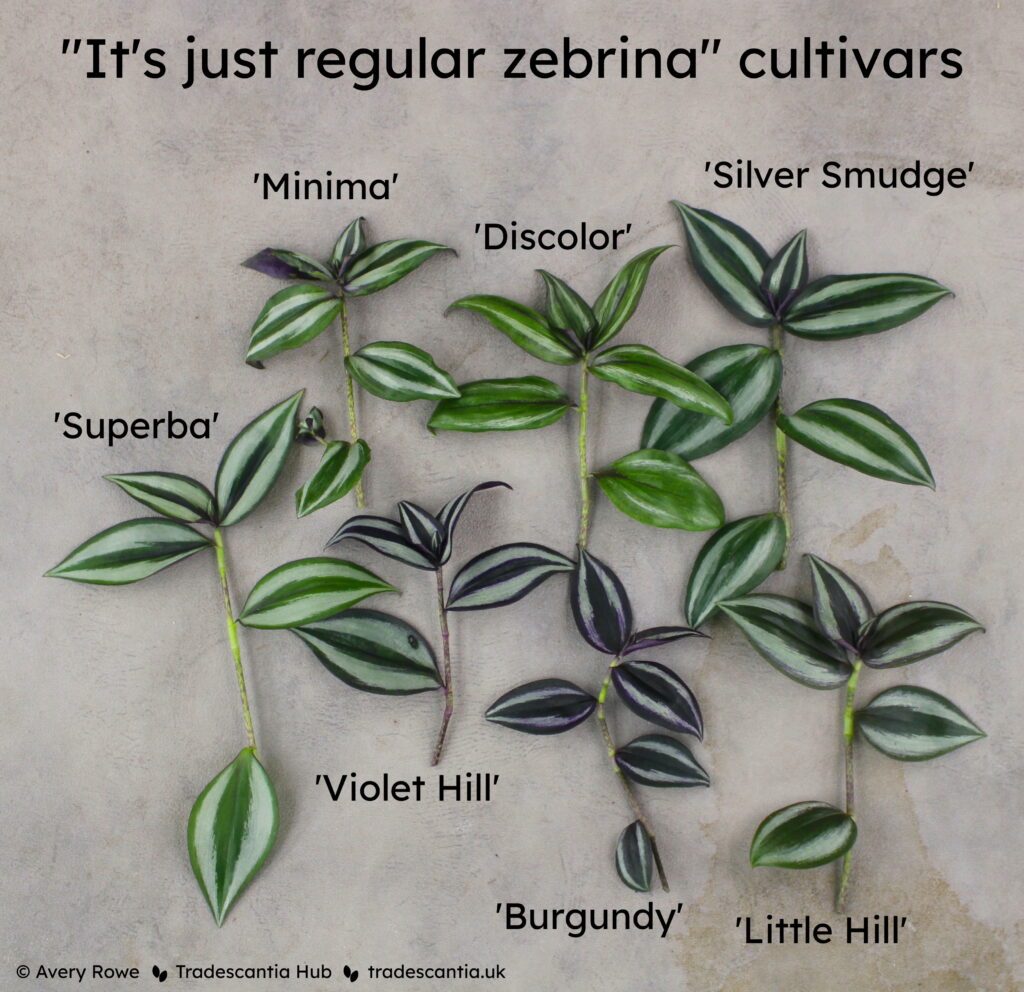
Pretty pictures
I don’t have much of a conclusion for this article. There are lots of zebrina cultivars and they can be difficult to tell apart! I’ll end with some pretty photo layouts.
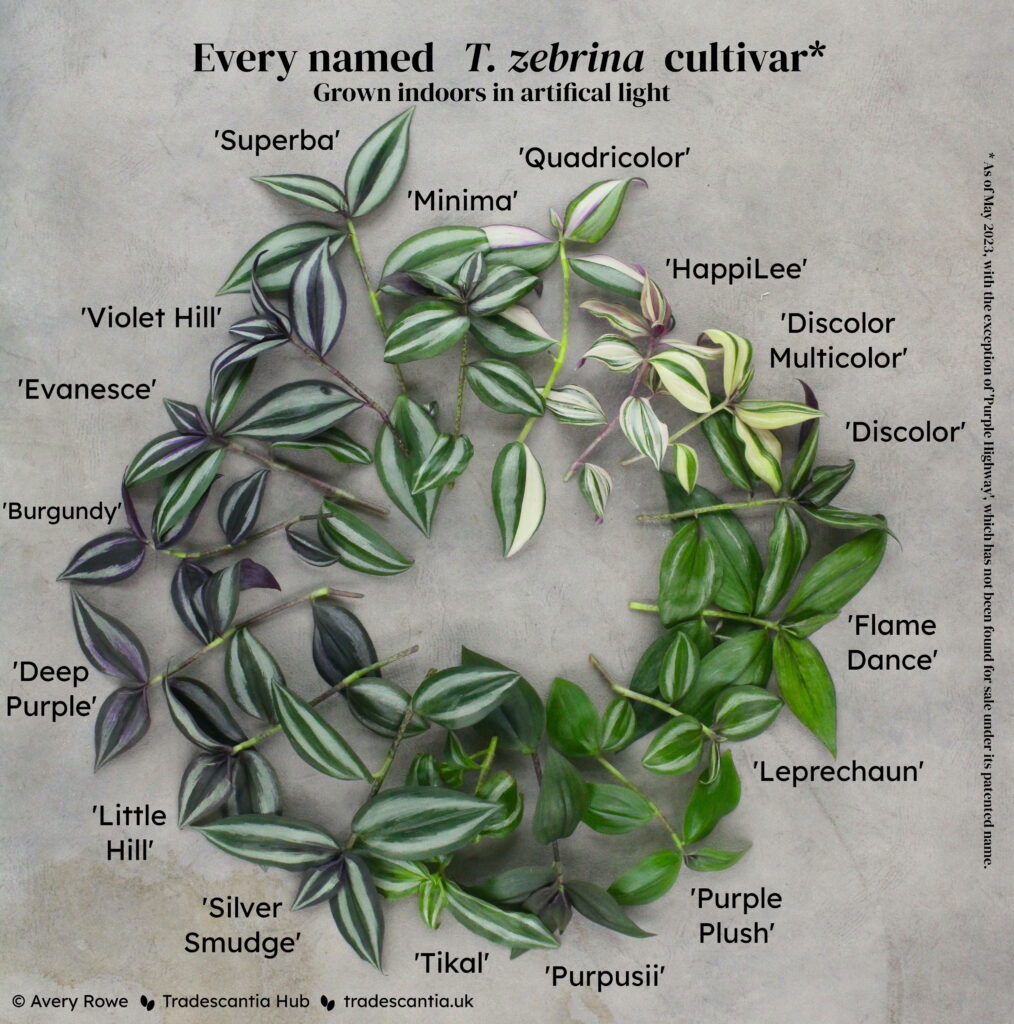
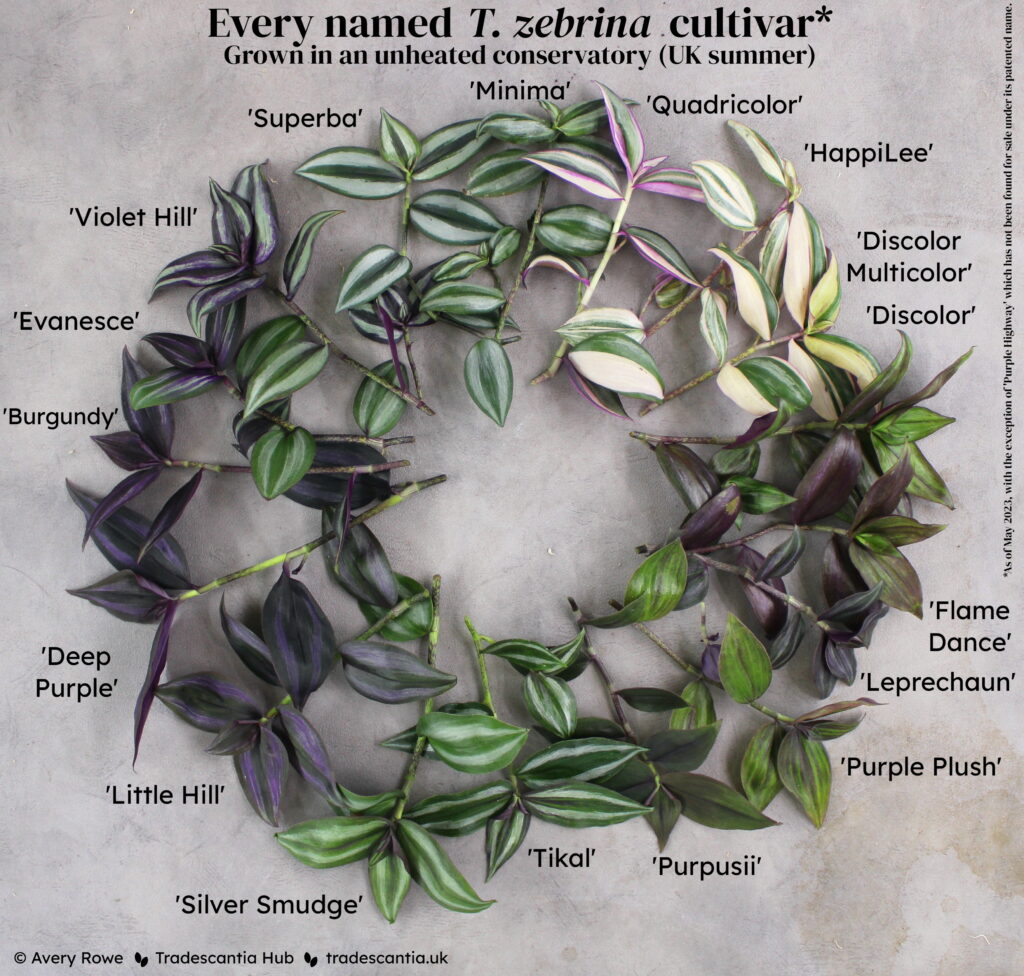
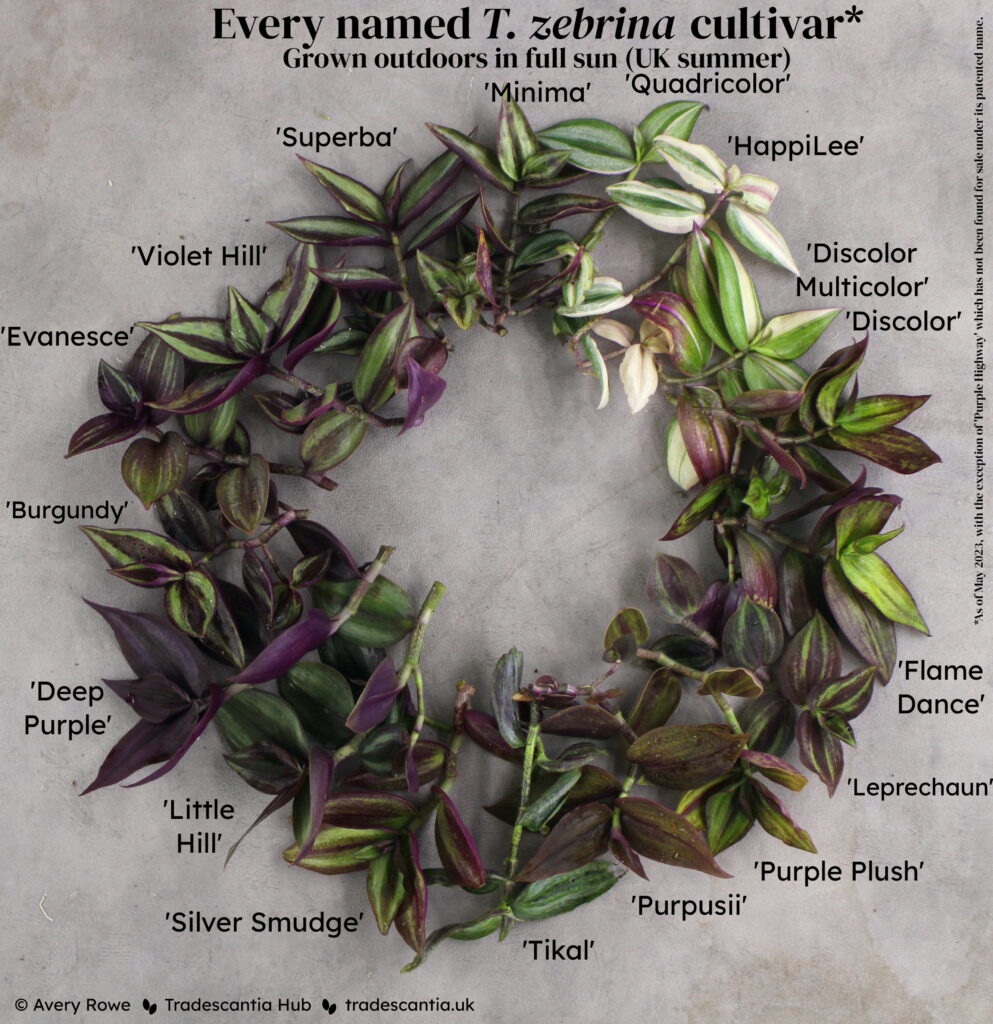
Found this article useful?
If you want more great resources like this, you can help me keep making them with a regular payment on Patreon.


13 replies on “Different types of Tradescantia zebrina”
Very informative. Thankyou. I am less confused about them now
Thank you for the informative, example-laden article. Also greatly appreciate the ‘gradiated wheel’ pretty pictures at the end! 🙂
Can any of the varieties be grown outdoors?
Yes, they can all be grown outdoors as long as temperatures are above 0ºC. Here in the UK they can stay outside all summer (but not through winter).
Still didn’t see the tradescantia that I showed you a picture of.
I’m afraid I don’t remember your picture. Did you email me?
They are not frost tolerant, but my experience and based on the local nurseries, these do great outdoors during the spring and summer.
Thanks!!
I really appreciated this very thorough description.
I have some tradescantia that grow wild under my arborvitae trees. They get a blue flower. Can I pot them up?
I can’t tell what species it might be without seeing it, but there’s no harm in trying!
You might be thinking of the asiatic day flower. (Commelina communis) I don’t know if it is related to these, but its growth sure looks similar. It is not native to North America, but it has spread. I have it in my yard too. I let some of them grow because I like the flowers.
Thank you. I didn’t realize there were so many varieties of this plant. I got a “purple striped” one with its old name from an older neighbor when I was 11 or 12. I got the impression it was in the “my grandmother gave it to me” category. It looks something like superba or silver smudge. Clear clean silver stripes on either green or purple depending on light. Backsides are almost always bright solid purple. I’ve always found it kind of special. There was another I used to have that my grandma called an inch plant, that was green and white variegated, but sadly that one passed on. It kept losing its variegation and would get ugly dried patches on its leaves. I figured it caught some disease.